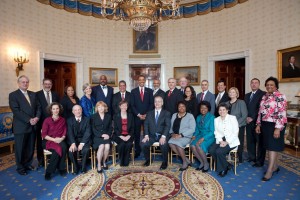CSUN Professor Celebrates 20th Edition of Student Research Abstracts
California State University, Northridge cancer researcher, mentor and professor Steven Oppenheimer is celebrating 20 years collaborating with Los Angeles Unified School District (LAUSD) teachers to promote science, technology, engineering and mathematics (STEM) for K-12 students.
The latest “New Journal of Student Research Abstracts” contains hundreds of science project abstracts from students across LAUSD. The abstract subjects range from hypothesizing how fast a plant will grow in fertilized or unfertilized soil to how different video games affect heart rates.

President Barack Obama poses with Presidential Awards for Excellence in Mathematics and Science Teaching winners in the Blue Room of the White House Jan. 6, 2010. CSUN’s Steven Oppenheimer is sitting in the first row, second from the left. (Official White House Photo by Samantha Appleton)
“I feel very satisfied that so many, literally thousands, of mostly middle and high school students are doing research,” said Oppenheimer, a professor in CSUN’s Department of Biology. “And, the journal is on the web for free! It’s getting bigger and bigger.”
Oppenheimer added that the abstracts provide students with interest in science.
“It’s a lot of fun. I feel it is serving a lot of students,” he said. “I have many teachers who have been working with me for decades. It is an outstanding group of people who help make this journal a great success.”
Terri Miller, a teacher at Oliver Wendell Holmes Middle School in Northridge, has been involved in the journal since 2000. She said working with the students on their abstracts has created more interest in science in her classroom.
“I think the most important thing is that [the journal creates] a lot of enthusiasm for science,” she said. “The kids are just very excited to get their work published. It means the world to them. It helps them to do their absolute best work.”
Oppenheimer said one of his favorite parts about the journal program is the annual symposium, where CSUN faculty and staff can meet the K-12 students, their teachers and parents to celebrate the science projects the students worked on.
“When the kids hear their names for a medal, the place is in uproar,” he said. “It is better than any sports game. That I think is one of the greatest things to see.”
Miller noted that the students showcase at CSUN every year has provided her students with an additional nudge toward being curious about science.
“We’re just so grateful for CSUN doing this for us,” she said. “It encourages [the students] to go on into science.”
Oppenheimer said the journal helps fill the need to promote STEM careers earlier in students’ academic life.
“There’s a national crisis in terms of getting enough new scientists [in the U.S.]. We believe that starting as early as possible to get students interested in research is the way to start getting new generations of excellent scientists,” he said. “Because in college, many people feel it is already too late. Students often have made up their minds in what they want to do. So starting, for example in middle school, to excite students in research is a key to protect the security, health and welfare of the country.”
The annual symposium will be at 10 a.m. on Sunday, March 13, in the University Student Union Grand Salon, located on the south east side of campus on 18111 Nordhoff St., Northridge. The event is free and open to the public. Parking is $6 per day. To see the journal online, go to http://scholarworks.csun.edu/handle/10211.3/125029.

 experience
experience